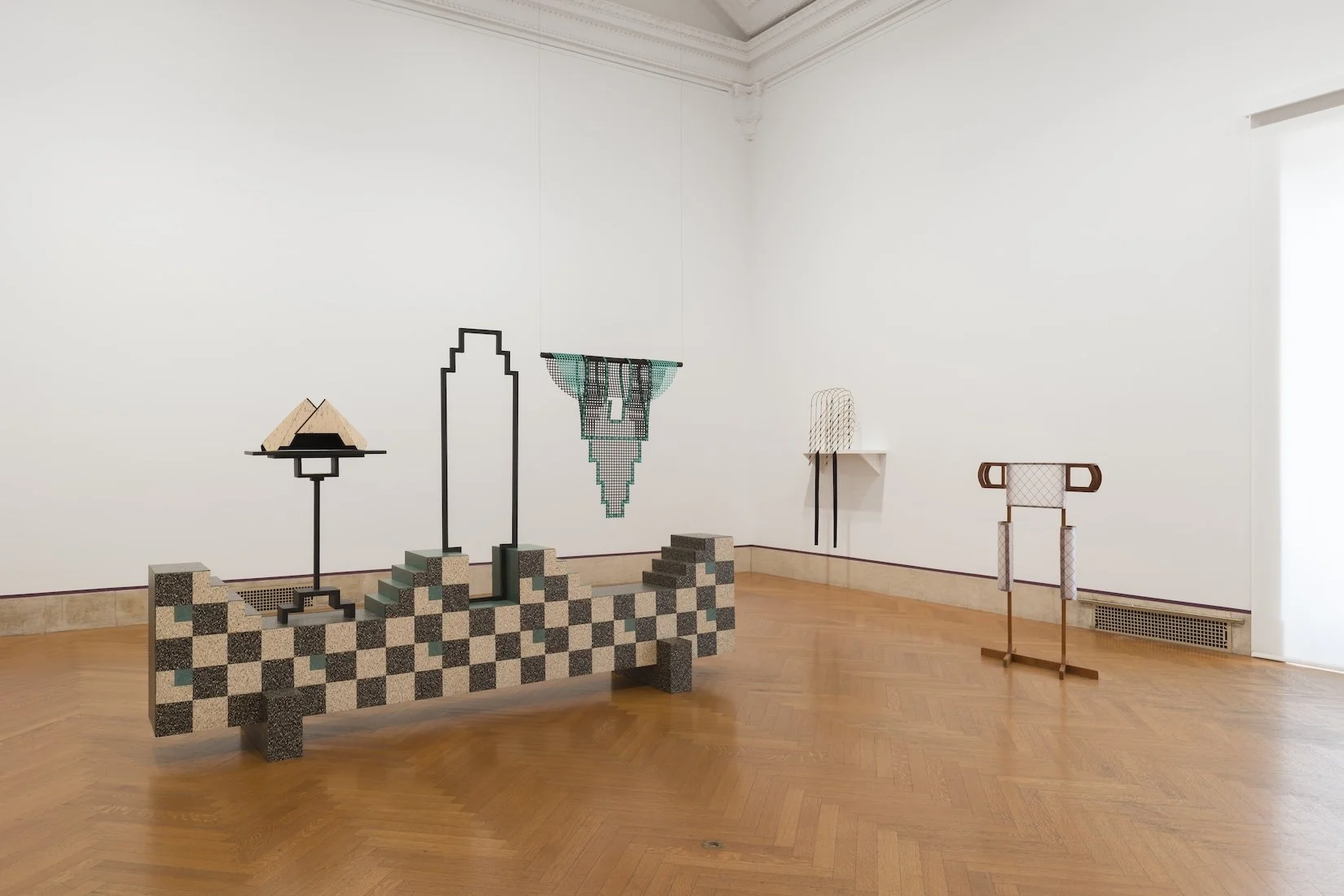Formal Wear
Artist Diane Simpson’s exhibition Formal Wear brings together over four decades of sculptures inspired by the forms of fashion, furniture and architecture (image: American Academy of Arts and Letters).
Chairs, hoop skirts and columns populate artist Diane Simpson’s exhibition, Formal Wear, at New York’s American Academy of Arts and Letters, each one appearing deceptively solid. As you circle the pieces, however, they begin to disappear – the chair’s slats spiral at an angle like a vanishing staircase, and the column is wide but thin, like the wrung tube of an ice lolly – each object glitching between two and three dimensions.
Simpson has approached art through the lens of design for over four decades, creating sculptures inspired by the forms of fashion, furniture and architecture. Starting with a visual reference such as the drape of an apron or the angle of a roof dormer, she creates axonometric drawings which are tilted at 45° in order to show multiple sides of an object at once – the same technique used by architects to visualise buildings. “The initial drawing alters the shape of the source object, sometimes quite a lot,” she explains. “But the surprise for me happens due to final choices of materials and colours that give it another new dimension.” Simpson selects similar materials to those used for prototyping in the design disciplines she references, such as cardboard, MDF and linen, turning what would usually be throwaway mock-ups into uncanny spectacles.
The earliest piece in the show is Simpson’s chaise longue created in 1976, which demonstrates the artist’s gradual shift from two to three dimensions (image: American Academy of Arts and Letters).
Early in her career, Simpson was inspired by artists Bernd and Hilla Becher’s photographs of industrial architecture such as lime kilns, water towers and grain silos, whose striking, monumental forms were a natural byproduct of functional and structural considerations. Despite being works of art, Simpson’s pieces also follow architect Louis Sullivan’s maxim “form follows function”, with seemingly decorative details such as pleats of cardboard or coils of thread always playing an essential role in the sculpture’s structural integrity. “I probably do everything the hard way, as a self-taught sculptor,” Simpson says, explaining that she originally studied painting at the School of the Art Institute of Chicago and developed most of her fabrication methods alone in her garage. “But there have been examples where my lack of experience has been to my advantage.” At the exhibition, an Amish bonnet made of brass wires angles cartoonishly over the edge of a plinth, its structure held together using colourful threads rather than welding. By finding an alternative construction technique that matched her skillset, Simpson added a level of craftsmanship to the piece, whose wrapped lattice recalls the joints of rattan furniture, which are often reinforced with thin strips of cane.
Simpson’s pieces are often inspired by antique fashion, incorporating the forms of hoop skirts, cinched corsets and draped sleeves (image: American Academy of Arts and Letters).
Despite this rigorous approach to form and function, the subjects of her sculptures are deeply ornamental, with Simpson often drawing references from the extravagant details of Victorian fashion. “I was especially interested in the formal richness,” she explains. “The exaggerated shapes of bonnets and the complex construction of hoop skirts.” At Arts and Letters, a bodice with puffed sleeves and a corseted waist is abstracted into a heart-shaped wardrobe, and the voluminous structure of a hooped underskirt is turned into MDF scaffolding clothed in delicate mesh rather than tarpaulin. Through her interest in ornament, Simpson deftly shows the overlaps between different design disciplines – her series inspired by peplum overskirts, which is illustrated at Arts and Letters through a shelf unit topped with an enamel waist, led her to consider the formal similarities they share with porticos, which are represented by a sculpture made from boards of MDF that angle over the corner of a room like a kilt.
While many of Simpson’s pieces are made using techniques derived from clothes construction, their flat-packed design is familiar to furniture fabrication. The earliest work in the show – a chaise longue created in 1976, which transitions from two dimensions to three, its back flat against the wall while its footstool extends into the room like a slide – is placed alongside her most recent works, which mark a return to furniture typologies. Her 2021 sculpture, Neighbor, distorts the form of the Adirondack outdoor lounge chair, its back elongated like a throne while its angled armrests creep towards the viewer. Simpson even takes inspiration from the advertisement of design, with a chequered sideboard on display that first appeared in her exhibition Window Dressing (2007-2008) for Racine Art Museum, which mimicked the form of a department store display. Backdrops made from vintage wallpaper and linoleum framed her surreal, garment-like sculptures, creating an installation that wouldn’t have looked amiss at a commercial trade fair.
The art deco hanging sideboard and hanging bib originally formed part of Simpson’s exhibition for Racine Art museum, where she created installations that mimicked the form of department store displays (image: American Academy of Arts and Letters).
Simpson’s pieces always reference the body – tempting it to sit down, open a drawer, or put on a headpiece – while remaining resolutely unwearable, unusable and uninhabitable. Somewhat comically, her work pays homage to design processes and designed objects while removing the functionality that is usually considered the foundation of the discipline. “One could say that it is a non-human-centered means of representation,” critic Glenn Adamson writes of Simpson’s axonometric style in Art in America, “which refuses to portray reality in accord with our expectations.” Simpson’s work unseats our familiar, anthropocentric reality; in her world, the prototype is the protagonist, and the scenography takes the starring role. Her uncanny perspective gives the impression that each piece of clothing, furniture or architecture is admiring itself in the mirror, pivoting to capture every angle of its fine form.
Words Helen Gonzalez Brown




